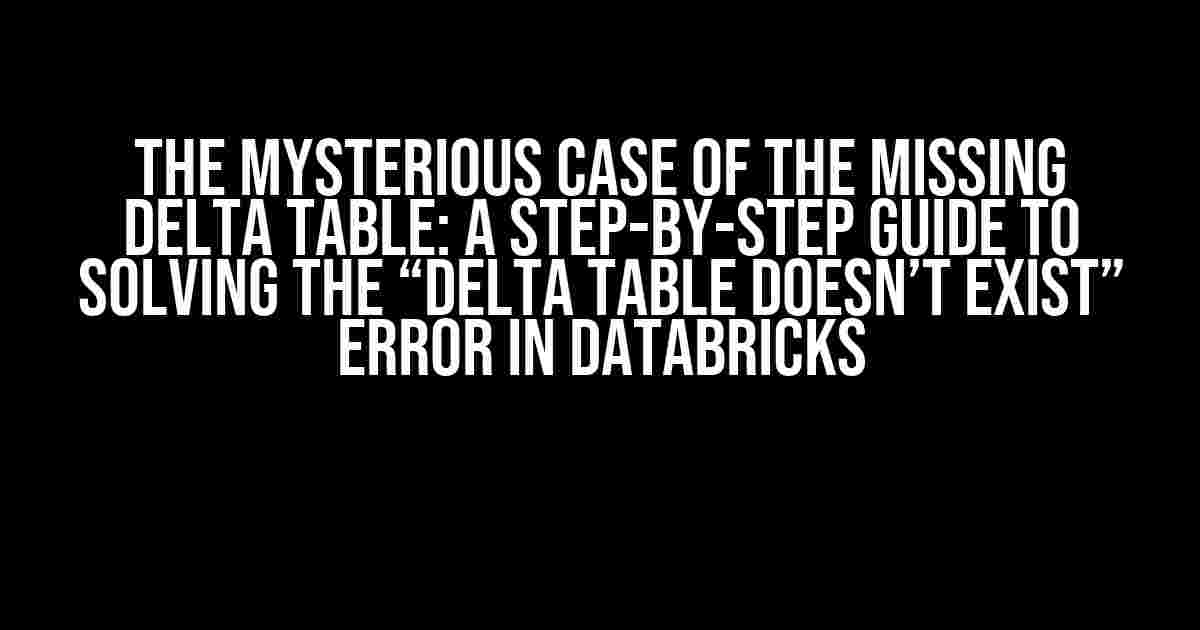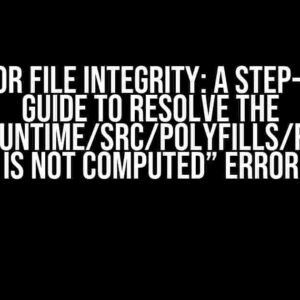If you’re reading this article, chances are you’re stuck in a frustrating predicament: you can’t select a table from your Databricks database in SQL, and you’re getting an error message that says “Delta table `default`.`incidents` doesn’t exist”. Fear not, dear reader, for you’ve come to the right place! In this comprehensive guide, we’ll delve into the world of Delta tables, Databricks, and SQL to uncover the root causes of this error and provide you with a clear, step-by-step solution to get you back on track.
- What are Delta Tables?
- The Error AnalysisException: Delta table `default`.`incidents` doesn’t exist
- Step 1: Verify the Table Existence
- Step 2: Check the Database and Schema
- Step 3: Verify the Table Type
- Step 4: Check for Permissions and Access Control
- Step 5: Invalidate the Cache
- Step 6: Re-run the SQL Query
- Common Causes and Solutions
- Conclusion
What are Delta Tables?
Before we dive into the troubleshooting process, let’s take a quick detour to understand what Delta tables are and how they work in Databricks. Delta tables are a type of table storage in Databricks that combines the benefits of data lakes and data warehouses. They’re optimized for performance, scalability, and reliability, making them an attractive choice for large-scale data processing and analytics.
Delta tables are built on top of Apache Parquet and use a proprietary format to store data. They’re designed to handle massive datasets and provide features like data versioning, auditing, and rollbacks, making them ideal for data engineers and analysts working with big data.
The Error AnalysisException: Delta table `default`.`incidents` doesn’t exist
Now that we’ve got a brief understanding of Delta tables, let’s tackle the error at hand. The “Delta table doesn’t exist” error typically occurs when you’re trying to query a Delta table in Databricks using SQL, but the table is not found in the specified database or schema. This error can manifest in various ways, such as:
AnalysisException: Delta table `default`.`incidents` doesn't exist
or
Error in SQL statement: AnalysisException: Delta table `default`.`incidents` doesn't exist
or
org.apache.spark.sql.AnalysisException: Delta table `default`.`incidents` doesn't existThe error message usually provides valuable information about the table name, database, and schema that’s causing the issue. In our example, the error is pointing to a table named “incidents” in the “default” database.
Step 1: Verify the Table Existence
The first step in resolving this error is to verify that the table actually exists in the specified database and schema. You can do this by running the following SQL command in Databricks:
SHOW TABLES IN default;This command will list all the tables in the “default” database. Look for the “incidents” table in the output. If it doesn’t exist, you might have misspelled the table name or it might be in a different database or schema.
Step 2: Check the Database and Schema
If the table doesn’t exist in the “default” database, try checking other databases and schemas. You can list all the databases in Databricks using:
SHOW DATABASES;Identify the correct database and schema where the “incidents” table resides. Update your SQL query to reflect the correct database and schema.
Step 3: Verify the Table Type
Delta tables have a specific type, which is “DELTA”. You can verify the table type using:
DESCRIBE FORMATTED default.incidents;Look for the “tableType” field in the output. If it’s not “DELTA”, you might be dealing with a different type of table.
Step 4: Check for Permissions and Access Control
Ensure that you have the necessary permissions and access control to read from the “incidents” table. You can check the permissions using:
SHOW GRANT ON TABLE default.incidents;Verify that your user or role has the required permissions to access the table.
Step 5: Invalidate the Cache
Sometimes, the Databricks cache can get stale, leading to issues with table access. Try invalidating the cache using:
REFRESH TABLE default.incidents;This command will refresh the metadata and cache for the “incidents” table.
Step 6: Re-run the SQL Query
After going through the above steps, re-run your original SQL query to see if the issue is resolved:
SELECT * FROM default.incidents;If you’re still facing issues, try restarting your Databricks cluster or checking the Databricks documentation for more troubleshooting tips.
Common Causes and Solutions
In addition to the steps outlined above, here are some common causes and solutions for the “Delta table doesn’t exist” error:
| Cause | Solution |
|---|---|
| Double-check the table name and schema. Verify that the table exists in the specified database and schema. | |
| Create the Delta table using the appropriate DDL command or check if the table was created successfully. | |
| Verify the correct database and schema for the Delta table. Update the SQL query to reflect the correct database and schema. | |
| Check the permissions and access control for the Delta table. Ensure that the user or role has the required permissions to access the table. | |
| Try invalidating the cache using the REFRESH TABLE command. This can help resolve issues with stale metadata and cache. |
Conclusion
In this article, we’ve covered the common causes and solutions for the “Delta table doesn’t exist” error in Databricks. By following the step-by-step guide and troubleshooting tips, you should be able to resolve the issue and access your Delta table successfully.
Remember to verify the table existence, check the database and schema, ensure correct permissions, and invalidate the cache if necessary. If you’re still facing issues, don’t hesitate to reach out to the Databricks community or seek further assistance.
Happy querying, and may the Delta tables be ever in your favor!
Frequently Asked Question
Stuck with a frustrating error message while trying to select a table from your Databricks DB? You’re not alone! Check out these common questions and answers to get back on track.
Why am I getting the error “AnalysisException: Delta table `default`.`incidents` doesn’t exist” when trying to select a table?
This error usually occurs when the table you’re trying to select doesn’t exist in the default database or the database you’re currently using. Make sure you’re pointing to the correct database and table by using the fully qualified name, such as `database_name.table_name`. If you’re still stuck, try running the `SHOW TABLES` command to list all tables in your database.
I’ve checked and rechecked, but the table definitely exists! What else could be causing the issue?
Sometimes, the issue might be due to permissions or access control. Ensure that your Databricks cluster has the necessary permissions to read from the table. Also, verify that the table is not temporarily unavailable or being modified by another process.
I’m using a Delta table, and I’ve tried everything. What’s specific to Delta tables that could be causing the problem?
Delta tables have some unique characteristics that might cause issues. Check if your Delta table is properly registered in the metastore using the `DESCRIBE FORMATTED` command. Additionally, ensure that the table is not in a state of `VACUUM` or `DROP`, which can cause temporary unavailability.
I’m using a notebook in Databricks, and I’ve tried running the query multiple times. Is there anything specific to notebooks that could be causing the issue?
Notebooks in Databricks can sometimes behave differently than expected. Try restarting your kernel or creating a new notebook to isolate the issue. Also, ensure that you’re running the query in the correct scope and that there are no syntax errors or typos in your code.
I’ve tried all the above solutions, and I’m still getting the error. What’s the next step?
Don’t worry, you’re not alone! If none of the above steps resolve the issue, try seeking help from the Databricks community or support team. They can provide more in-depth guidance and help you troubleshoot the problem. Additionally, you can also try debugging your code, checking the Databricks logs, or seeking help from a colleague or mentor.



